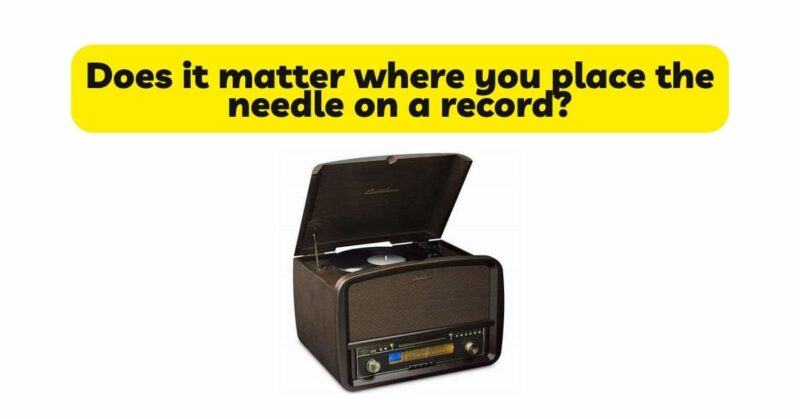Playing vinyl records on a turntable is a cherished experience for music enthusiasts. One aspect that often sparks discussion is the placement of the needle on the record. Does it matter where you place the needle? In this article, we will explore the significance of needle placement and its impact on sound quality, record preservation, and overall listening enjoyment. By understanding the factors at play, you can make informed decisions to optimize your vinyl playback experience.
- The Groove Structure: To understand the importance of needle placement, it’s crucial to recognize the structure of vinyl records’ grooves. Each record contains spiral grooves that carry the audio information. The grooves consist of two walls: the left and right walls that form the channel where the stylus rides. The position of the stylus on these walls affects the sound reproduction.
- The Importance of Alignment: Proper alignment of the needle on the groove walls is essential for optimal playback. Alignment ensures that the stylus accurately tracks the groove, minimizing distortion, wear, and excessive pressure on one side of the groove. Incorrect alignment can lead to suboptimal sound quality and potential damage to the stylus and the record.
- Inner and Outer Grooves: Vinyl records typically have varying grooves from the inner to the outer edges. The inner grooves have a smaller diameter and, consequently, a narrower spiral. As a result, the stylus covers a shorter distance per revolution compared to the outer grooves. Placing the needle too close to the center can result in reduced sound quality, as the stylus might not capture the entire range of audio information encoded in the grooves.
- Finding the Sweet Spot: To achieve optimal sound quality, it is important to find the “sweet spot” on the record where the stylus performs best. The sweet spot is typically located between one-third and two-thirds of the distance from the center to the outer edge of the record. Placing the needle within this range allows for more accurate tracking, better channel balance, and optimal reproduction of the recorded music.
- Avoiding the Lead-In Groove: At the beginning of each side of a record, there is a lead-in groove. This groove often contains silence or non-musical information. Placing the needle on the lead-in groove can result in unnecessary wear on the stylus and the record. It is advisable to position the needle just past the lead-in groove to ensure a smoother start to the musical content.
- Skips, Jumps, and Groove Damage: Incorrect needle placement can lead to skips, jumps, or even groove damage. Placing the needle too close to the center or too far out towards the edge increases the likelihood of tracking errors, causing the stylus to jump across the grooves or skip portions of the music. These issues not only disrupt the listening experience but can also damage the grooves over time.
- Record Wear and Preservation: Proper needle placement is crucial for record preservation. Placing the needle consistently in the same area of the record can cause excessive wear on that specific section, leading to groove damage, increased surface noise, and diminished sound quality. Rotating the record periodically or using a turntable with an automatic tonearm return can help distribute the wear more evenly across the entire surface.
- Adjusting Tracking Force: In addition to needle placement, it is important to consider the tracking force—the downward pressure exerted by the stylus on the record. Different cartridges and styli require specific tracking forces for optimal performance. Properly adjusting the tracking force ensures that the stylus remains in contact with the groove walls without excessive pressure, minimizing groove wear and improving sound quality.
- Record Warps and Deformations: Vinyl records can suffer from warps and deformations, which affect needle placement. Warps can cause the needle to jump or skip when it encounters a distorted section of the groove. In such cases, it is advisable to carefully adjust the needle placement to avoid the affected area, allowing for smoother playback.
- The Role of Turntable Calibration: The calibration of a turntable’s tonearm plays a crucial role in achieving accurate needle placement. Properly aligning the tonearm and setting the correct tracking force ensure that the stylus is in the optimal position within the grooves. Consulting the turntable’s user manual or seeking guidance from a knowledgeable audio specialist can help ensure the proper calibration of your turntable.
Conclusion: The placement of the needle on a vinyl record significantly impacts sound quality, record preservation, and overall listening enjoyment. By understanding the importance of alignment, avoiding lead-in grooves, finding the sweet spot, and adjusting tracking force, you can optimize your playback experience. Proper needle placement helps minimize distortion, groove wear, skips, and jumps while preserving the integrity of your records. Additionally, the calibration of your turntable’s tonearm is crucial for accurate needle placement. By paying attention to these factors and implementing best practices, you can fully immerse yourself in the captivating world of vinyl playback, appreciating the full depth and richness of your cherished music collection.

